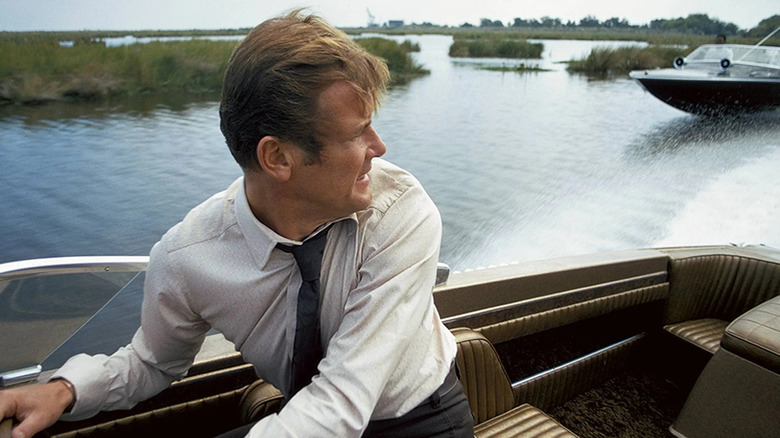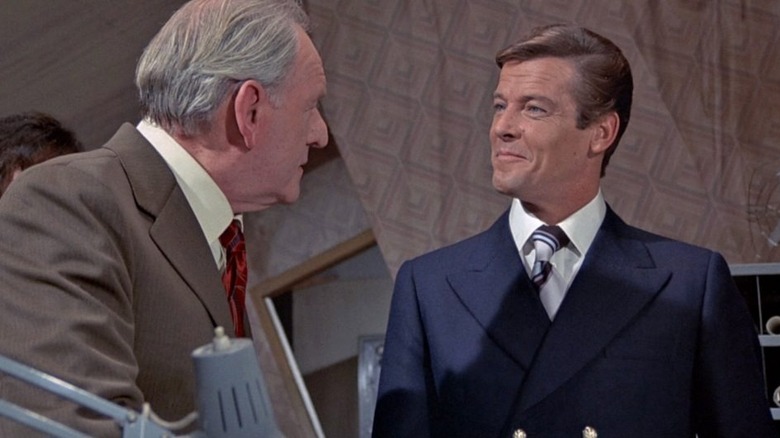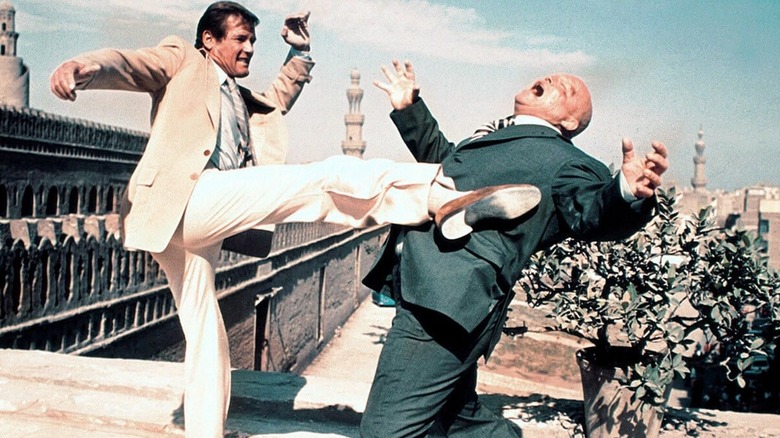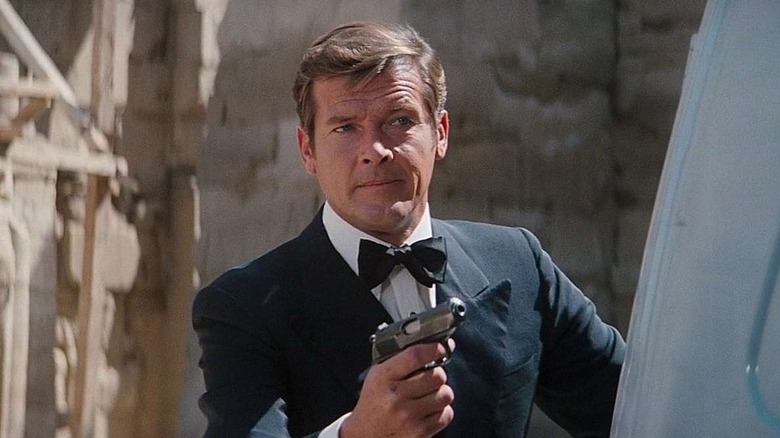How Roger Moore Separated His James Bond From The Sean Connery Image
Sean Connery in the role of James Bond is the very definition of a tough act to follow. Most actors who have the good fortune to portray a character on screen for the first time become associated with that character by default, but Connery did more than perfectly portray novelist and creator Ian Fleming's British spy — he defined the character completely, turning Bond into an icon.
Connery was rakishly handsome, effortlessly charming, and devilishly witty while also being able to tap into 007's coldness. His performance did the heavy lifting in explaining how a man with a license to kill is able to operate on a daily basis, and slyly offset the kitschy tone of the films by giving a grounded darkness to the character. When Connery briefly exited the role, Eon Productions recast Bond with George Lazenby, who was only afforded one at-bat in 1969's "On Her Majesty's Secret Service." That's because, despite the high quality of the film itself, Lazenby was either ordered or felt pressured to hew close to Connery's Bond, which was a poor fit for the more easygoing Australian actor.
After Connery left the role for the second time following 1971's "Diamonds Are Forever," actor Roger Moore was approached to take over. Already a veteran of numerous films and television series (including the spy-themed shows "The Saint" and "The Persuaders"), Moore knew that attempting to do a thinly-veiled impression of Connery would be a losing game. Instead, Moore took Bond in a new direction, one that helped prove the malleability and versatility of the character and the films themselves.
Moore makes Bond his own by avoiding the Connery comparison altogether
One of the missteps taken by "On Her Majesty's Secret Service" is the way it plays around with the continuity of the Bond films and character. In the opening sequence, Lazenby's Bond addresses the camera and says "This never happened to the other fella," while in a later scene he looks over a few memorable items in his office from the films that had starred Connery. In Connery's short-lived return to the role, "Diamonds Are Forever," the subject of plastic surgery is brought up as a low-key way of explaining the reason why Bond (and his nemesis Blofeld) looks different from time to time.
When director Guy Hamilton and Moore embarked on making Roger Moore's first Bond film, 1973's "Live and Let Die," the two men agreed that divorcing the film from its predecessors was the ideal approach. As Moore explained during a 1981 interview with Dick Cavett:
"[Hamilton] said we will deliberate — you know, because obviously you've got to say "My name is..." I said, because that's the thing that wakes me up at night, I keep hearing myself saying, "My name is Bond, James Bond," and I mustn't do that, you know, because I can't do any more. That's the limit of my talent as a mimic. And so he said we will avoid things like "shaken, not stirred," anything that Sean did, and that's really the only thing that went into it."
Moore almost ends his Bond tenure early by inching towards Connery's style
"Live and Let Die" was a success in numerous ways, including and especially regarding audiences' acceptance of Moore as James Bond. Thus, Moore, Hamilton, and producers Harry Saltzman and Albert R. Broccoli rushed "The Man With the Golden Gun" into production in 1974, and nearly sunk the franchise — it remains the fourth lowest-grossing film in the Bond series.
There are several reasons why "Golden Gun" is a misfire, but in this writer's estimation it's largely because Moore attempts to play Bond in a fashion closer to Connery's. As Moore said in the Cavett interview, "I was a little more gentle with ladies until the second one, when I was allowed to break an arm or two." Moore didn't have quite the same darkness that Connery (and, later, Timothy Dalton and Daniel Craig) possessed, making his more brutish Bond in "Golden Gun" feel forced. Bond films have survived as long as they have by finding a workable template (or "formula," as Broccoli and Saltzman originally called it), and "Golden Gun" proved that the old template needed updating for the series' new star.
Moore finds Bond's groove
With 1977's "The Spy Who Loved Me," Roger Moore discovered his own personalized take on the character of James Bond. It was an approach successful enough that it kept Moore in the role for four subsequent movies, making his tenure the longest of any of the Bond actors so far.
Moore's secret was to lean into the inherent comedy of the films and the role, which played to his own personal strengths as a performer. In a 2008 interview, Moore explained his take on the role:
"I tried to find out what Bond was all about, but you can't tell much from the books. There's the line that says 'He didn't take pleasure in killing, but took pride in doing it well.' So that's what I did. But the other side of me was saying, 'This is a famous spy — everyone knows his name, and every bartender in the world knows he likes martinis shaken, not stirred. Come on, it's all a big joke!' So most of the time I played it tongue-in-cheek."
Moore's ultimate approach to the part was so different from Connery's that many fans took offense. While "which James Bond is the best"-type questions are generally tiresome, the fact that a debate can be had about the pros and cons of each actor to play the role is a testament to Moore's work — even Connery admitted that Moore "took another direction" with the character.
While Moore was always self-deprecating about his efforts, a close viewing of his Bond performances reveal a lot of nuance in his portrayal — his turn in 1981's "For Your Eyes Only" is still underrated, as it's a much more successful blending of Fleming's hard-edged Bond with Moore's devil-may-care take than "Golden Gun" was. Moore liked to say that his Bond always had an inkling that he was going to win the day in the end, and as far as his legacy being associated with the character goes, Roger Moore has indeed been victorious.



